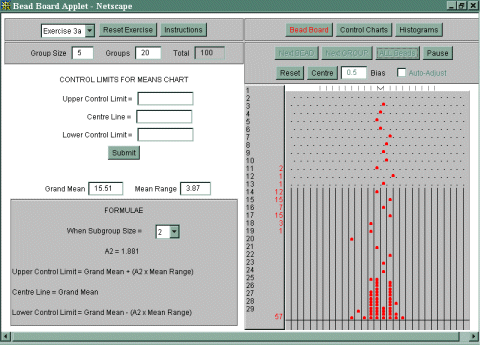
| The Bead Board Applet |
A bead board (also called a quincunx) is a tool used to simulate random patterns of behaviour. It is made up of a panel of regularly spaced pins, above a row of bead collectors. Beads are dropped into the board at the top, and pass through the pin panel. At each pin, a bead will fall either to the left or the right (in the same way as a fairground 'penny falls' machine). Once it has passed right through the pin panel, the bead will end up in one of the collectors at the bottom. The accumulation of the beads in each collector provides a model of the distribution of the output of a controlled process.
An applet is a JavaTM program which can be embedded into a web page and is run when you load that page into your browser. Because the program runs directly on your machine and not on the internet host, it is possible to include a considerable amount of user interaction without the time delay of contacting the server each time a button is pressed or a line of text is typed. However, depending on the complexity of the program and the type of browser that you are using, there may be some delay while the program is first downloaded and initialised. This is unfortunate but inevitable and we would ask you to be patient while the program is set up for the first time.
The bead board applet is divided into two sections.

The Simulation Panel is, in fact made up of three different components:
You can switch between these three different views by using the
buttons at the top of the panel.